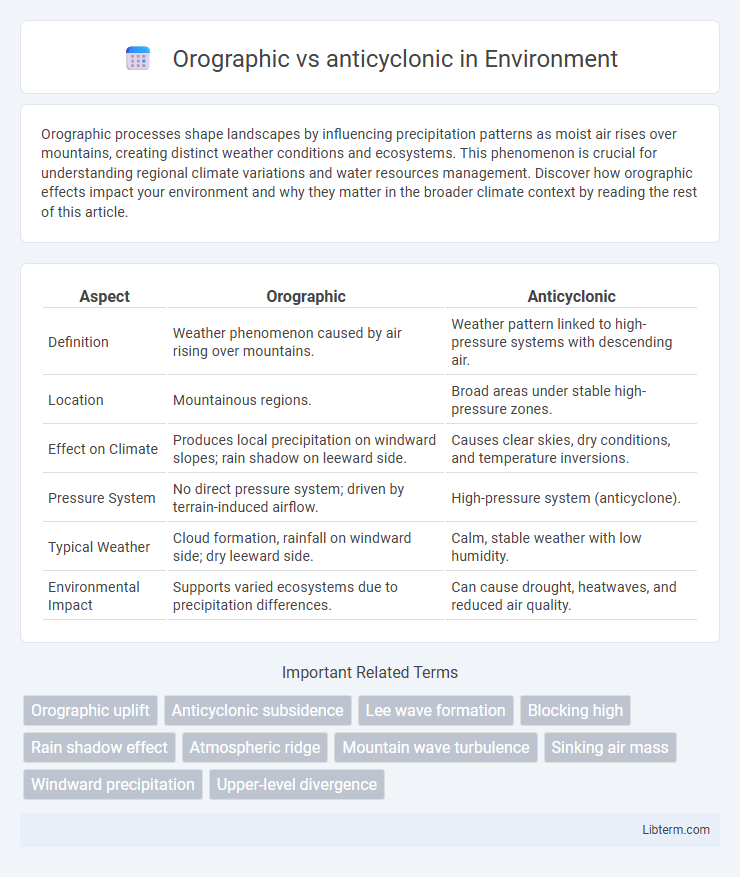Orographic processes shape landscapes by influencing precipitation patterns as moist air rises over mountains, creating distinct weather conditions and ecosystems. This phenomenon is crucial for understanding regional climate variations and water resources management. Discover how orographic effects impact your environment and why they matter in the broader climate context by reading the rest of this article.
Table of Comparison
| Aspect | Orographic | Anticyclonic |
|---|---|---|
| Definition | Weather phenomenon caused by air rising over mountains. | Weather pattern linked to high-pressure systems with descending air. |
| Location | Mountainous regions. | Broad areas under stable high-pressure zones. |
| Effect on Climate | Produces local precipitation on windward slopes; rain shadow on leeward side. | Causes clear skies, dry conditions, and temperature inversions. |
| Pressure System | No direct pressure system; driven by terrain-induced airflow. | High-pressure system (anticyclone). |
| Typical Weather | Cloud formation, rainfall on windward side; dry leeward side. | Calm, stable weather with low humidity. |
| Environmental Impact | Supports varied ecosystems due to precipitation differences. | Can cause drought, heatwaves, and reduced air quality. |
Introduction to Orographic and Anticyclonic Phenomena
Orographic phenomena occur when airflow is forced to ascend over mountain ranges, leading to precipitation on the windward side and dry conditions in the rain shadow area, significantly impacting local climate patterns. Anticyclonic phenomena involve high-pressure systems where air descends and diverges, resulting in stable weather conditions, clear skies, and reduced precipitation. These distinct atmospheric processes are crucial in meteorology for understanding weather variability and forecasting precipitation distribution across different geographic regions.
Defining Orographic Precipitation
Orographic precipitation occurs when moist air masses are forced to ascend over mountain ranges, cooling adiabatically and condensing to form rain or snow on the windward slopes. This phenomenon contrasts with anticyclonic conditions, where descending air in high-pressure systems suppresses cloud formation and precipitation. The defining characteristic of orographic precipitation is the interaction between topography and atmospheric moisture, resulting in localized heavy rainfall dependent on elevation and prevailing wind direction.
Understanding Anticyclonic Conditions
Anticyclonic conditions are characterized by high atmospheric pressure, leading to stable, clear skies and subsiding air that inhibits cloud formation and precipitation. These weather patterns often cause prolonged dry spells and temperature inversions that can trap pollutants near the surface. Understanding anticyclonic dynamics is crucial for predicting air quality and agricultural impacts in regions prone to such stable weather systems.
Key Differences: Orographic vs Anticyclonic Systems
Orographic systems occur when air masses are forced to rise over mountains, causing precipitation and cloud formation on windward slopes, while anticyclonic systems are large high-pressure areas characterized by descending air, leading to clear skies and stable weather conditions. Orographic effects dominate localized weather patterns due to topography, whereas anticyclones influence broader regional climates by altering wind circulation and suppressing cloud formation. Key differences include the mechanism of air movement--uplift in orographic systems versus subsidence in anticyclonic systems--and their contrasting impacts on precipitation and weather stability.
Mechanisms Behind Orographic Processes
Orographic processes occur when moist air masses encounter mountain ranges, forcing the air to ascend, cool, and condense, resulting in precipitation on the windward side and creating a rain shadow on the leeward side. This lifting mechanism increases cloud formation and rainfall due to adiabatic cooling and the release of latent heat. In contrast, anticyclonic processes involve descending air in high-pressure systems that suppress cloud formation and lead to clear, stable weather conditions.
Atmospheric Dynamics of Anticyclonic Events
Anticyclonic events are characterized by high-pressure systems with descending air that stabilizes the atmosphere, reducing cloud formation and leading to clear skies. Orographic effects occur when air masses interact with topography, causing air to rise and cool, often resulting in precipitation on windward slopes and dry conditions on leeward sides. In contrast, anticyclonic dynamics suppress vertical motion, limiting orographic uplift and significantly influencing local weather patterns by maintaining dry and stable conditions.
Impact on Local and Regional Weather Patterns
Orographic effects cause localized precipitation and temperature variations by forcing moist air to rise over mountains, leading to enhanced rainfall on windward slopes and drier conditions on leeward sides. Anticyclonic conditions, characterized by high-pressure systems, promote stable, clear weather with suppressed cloud formation, affecting large regional areas through prolonged dry spells and temperature inversions. These phenomena collectively influence microclimates and seasonal weather patterns, crucial for water resource management and agricultural planning.
Examples of Orographic and Anticyclonic Scenarios
Orographic scenarios typically occur when moist air masses are forced to ascend over mountain ranges, such as the Sierra Nevada causing heavy precipitation on the windward side and rain shadows on the leeward side. Anticyclonic scenarios are characterized by high-pressure systems, often resulting in clear, calm weather, exemplified by the Bermuda High influencing the eastern United States' summer climate. Mountain ranges in the Pacific Northwest and the stable, dry conditions under the Azores High serve as prime examples of orographic and anticyclonic phenomena, respectively.
Implications for Climate and Environment
Orographic effects cause localized climate variations by forcing moist air to rise over mountains, leading to increased precipitation on windward slopes and arid conditions on leeward sides, impacting vegetation and water resources. Anticyclonic conditions, characterized by high-pressure systems and subsiding air, typically result in stable, dry, and clear weather patterns that can exacerbate droughts and increase air pollution concentrations. Understanding the interaction between orographic influences and anticyclonic stability is crucial for predicting regional climate impacts, managing ecosystems, and planning sustainable water management strategies.
Conclusion: Choosing the Right Approach for Analysis
Orographic and anticyclonic analyses serve distinct roles in meteorological studies, with orographic methods focusing on terrain-induced weather patterns and anticyclonic approaches emphasizing large-scale high-pressure systems. Selecting the appropriate method depends on the specific atmospheric phenomena, geographic features, and temporal scales involved in the study. Integrating both approaches when relevant can enhance the accuracy of weather predictions and climate models by capturing the complex interactions between topography and atmospheric pressure systems.
Orographic Infographic

 libterm.com
libterm.com